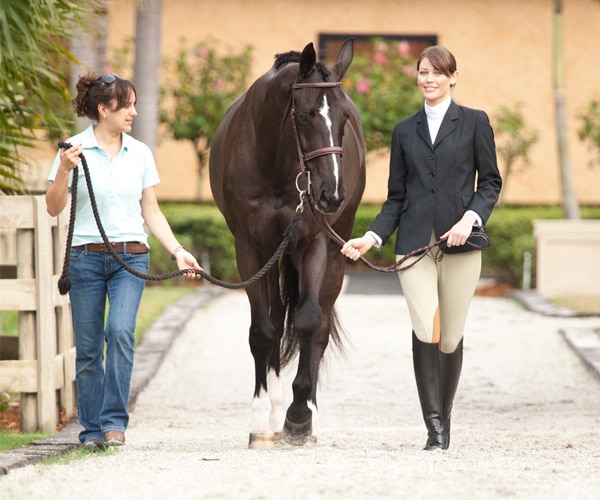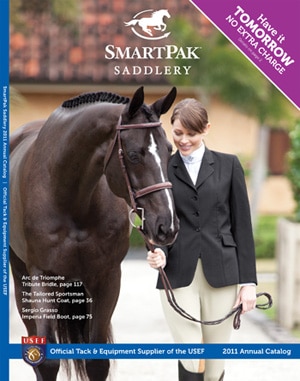Making the Cover: Behind the Scenes with SmartPak

Our photo shoots remind me a lot of horse show days. Early mornings, long days, tight schedules, plenty of surprises, and an absolute labor of love.
First Things First

The 2011 SmartPak Spring Catalog
As the official SmartPak photo shoot groom, my day usually starts while the grass is still soaked with dew. I walk into the barn, find the horse for the first shot and get to work. In other parts of the barn, the rest of the team is starting their prep work, too. Steamers are warming up. Racks of clothes are rolling up the aisles. Locations for each shot are being scouted. Human models settle in for hair and make-up. As the barn is waking up for the morning, little pieces and parts are being transformed into the perfect background for what we hope will become the perfect shots.
The early morning barn staff always seems a little amused, and occasionally more than a little confused, by things that seem totally normal to us. In fairness, putting baby powder on the horse’s socks isn’t really an everyday occurrence. And sometimes we’re legitimately weird – like the time I pretended the curry comb was a monster’s mouth, and made it “nom” the nose of our pony model, Barbie. (Our photographer’s husband still talks about that.)
Ready, Set, Freeze
Once the real action starts, things go from “hm, that’s odd” to “ok, these people are nuts.” I usually handle the horses during shooting, since we get to know each other during “hair and makeup.” Just like with human models, every shot is thoughtfully posed. Each hoof is carefully placed, the horse has to be angled just so, and the product has to look perfect. Blankets are especially fun because if the horse takes a step, we have to reposition, then tug and adjust the blanket to make sure it’s sitting evenly and as wrinkle-free as possible. That means one stamp at a bothersome fly, or even one shift of weight to rest a foot, and we have to reset.
Once the horse is set, I have to get out of the shot. Since I’m the only one holding the horse, I need to stay close enough so that he doesn’t try to move, but far enough away that I’m out of the frame. This unusually involves a little bit of physical dexterity, and a lot of hope. Each time I say, “whoa, good boy,” it’s a mixture of instruction for the horse and a little bit of prayer.
Play it by Ear
In addition to handling the horse, I also run point on “ear patrol,” though I often have to call for back-up, (it’s tough saying “stand still” while also saying “look at this!”). As you know, ears forward is a horse’s way of smiling, and, unfortunately, horses don’t understand “say cheese!” There is one thing that is universally understood, though, and that’s the noise that food makes. But it’s important to balance getting the horse’s attention and being overly enticing, otherwise your beautiful model turns into a treat-seeking missile, and walks right out of the frame. We have a variety of different “triggers” we use to coax the ears forward, with each of these being guaranteed to work about 1/3 of the time:
- Gently shaking a bucket of grain or a bag of treats
- Sprinkling a handful of grain into an empty bucket
- Crinkling a peppermint wrapper
- Snapping a carrot in half (biting into the carrot works, too!)
- Tearing up handfuls of grass (a great option if you also want the horse to put his head down)
Some horses can get over-stimulated by these delicious and tempting sounds, which makes for quite the fidgety model (which makes for a lot of resets, which isn’t fun for anyone). In those instances, we’ll turn to inedible attention getters. My personal favorite is a pink and white pompom from my days on the Customer Care Team (our phone team knows how to have fun!). (Interesting side note: in addition to flying to Florida for our annual spring photo shoots, my pompom was with me for all 39.3 miles of the Avon Walk for Breast Cancer!) The pompom is visually interesting, makes a fun sound, and isn’t something most horses have seen before, so it’s really good at eliciting that “oooo, what’s that?” expression, which photographs beautifully. However, because all models are different, it’s important to introduce the pompom slowly and carefully – there is a big difference between “oooo, what’s that?” and “WHAT IS THAT!?”, with the latter resulting in a not-so-photogenic expression.
Occasionally, we’ll have a particularly disinterested model. Treats, grain, pompoms – nothing seems to phase him. While it’s great to have such a calm and quiet horse, “bored” is not the look we’re going for. But to get a new model fully groomed and dressed takes a lot of time, so we’ve been known to get creative when trying to get a “smile.” The whole team gets involved, taking off our jackets and waving them like flags, shuffling our feet in the gravel, folding the leather lead in half and “cracking” or “snapping” the leather, shaking or squeezing plastic water bottles, twirling a broom like a baton, and, my personal favorite, the time when one of us took a mouthful of water and spit it out, a la a cherub in a fountain (hey, it worked!).
The Human Element
Adding a human model into the shot adds a whole other level of complexity. The vast majority of the models we use are professionals with little to no horse experience, so every little thing they do, from how to hold the reins to where to stand, has to be explained. This is where the human models start to think I’m crazy. While they’re holding the reins and walking on the right side, I’m holding a lead line off to the left, walking with them and saying things like “Look at him like you love him. Like he just won you a big, blue ribbon. Tell him he’s a baby. A big, handsome, kissable baby boy!” The point isn’t to convince them that I’m completely insane, it’s to help them get comfortable enough to genuinely laugh and smile, so that we can get an image that really captures the irreplaceable feeling that we riders have when we’re walking with our horses.
A Photo Finish
After shooting thousands of frames over the course of 8+ hours, it’s time to pack it up, thank the barn staff, tuck the horses in and head home. Every shoot takes a lot of hard work, and probably even more luck, but every time, I come home feeling like the luckiest person in the world. To paraphrase Joe DiMaggio, “I’d like to thank the good Lord for making me a SmartPaker.”